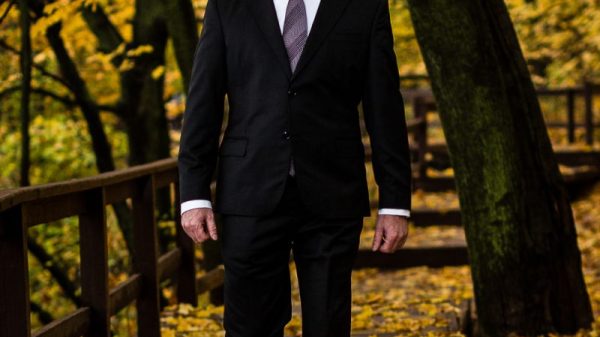Tim Sheehy, a charismatic former Navy SEAL who is the Republican candidate in a U.S. Senate race in Montana that could determine control of the chamber, has cited a gunshot wound he received in combat that he said left a bullet in his right arm as evidence of his toughness.
“I got thick skin — though it’s not thick enough. I have a bullet stuck in this arm still from Afghanistan,” Sheehy said in a video of a December campaign event posted on social media, pointing to his right forearm.
It was one of several inconsistent accounts Sheehy has shared about being shot while deployed. And in October 2015, more than a year after he left active duty, he told a different story.
After a family visit to Montana’s Glacier National Park, he told a National Park Service ranger that he accidentally shot himself in the right arm that day when his Colt .45 revolver fell and discharged while he was loading his vehicle in the park, according to a record of the episode filed in U.S. District Court for the District of Montana.
The self-inflicted gunshot left a bullet lodged in Sheehy’s right forearm, according to the written description accompanying the federal citation that the ranger, a federal law enforcement officer, gave Sheehy for illegally discharging his weapon in a national park. The citation said the description was based on Sheehy’s telling of events.
Asked this week about the citation, which has not been previously reported, Sheehy told The Washington Post that the statement he gave the ranger was a lie. He said he made up the story about the gun going off to protect himself and his former platoonmates from facing a potential military investigation into an old bullet wound that he said he got in Afghanistan in 2012. He said he did not know for certain whether the wound was the result of friendly fire or from enemy ammunition, and said he never reported the incident to his superiors.
Sheehy said he did not shoot himself in the park in 2015, but rather fell and hurt himself on a hike, necessitating a trip to an emergency room, where he said he told hospital staff he had a bullet in his arm, triggering his interview with the ranger.
“I guess the only thing I’m guilty of is admitting to doing something I never did,” Sheehy said of paying a $525 fine for illegally discharging his weapon in the national park; he now says the gun never went off in the park. He added of his platoonmates: “It was a small price to pay to make sure that a whole team of really great Americans didn’t get dragged through the mud over this.”
Lying to a federal officer is a crime, though it is past the statute of limitations for prosecution. People are sometimes charged with lying to National Park Service rangers, a review of cases found, often in instances in which they are stopped and questioned and provide a false name.
A lawyer for Sheehy, Daniel Watkins, said that because no crime had taken place, Sheehy did not impede or obstruct a law enforcement investigation.
Sheehy’s latest account of his arm wound is one of several differing descriptions he has given of being shot while deployed. In his 2023 memoir “Mudslingers,” he wrote in one passage that he received multiple bullet wounds in Afghanistan. In another, he wrote that his body was hit by a bullet just once. In the book, he also offers varying accounts of how he was shot.
Asked why he wrote in his book that he was shot by friendly fire in Afghanistan after he said he lied to the ranger about the incident in 2015, Sheehy said that the passage of time had eased his fears of his old injury sparking a military investigation.
The Sheehy campaign did not make available any witnesses who were with Sheehy when he said he was hiking with his family and did not provide medical records from the 2015 hospital visit, saying he had requested them but was unable to obtain them immediately. The campaign also declined to give permission for hospital officials to discuss his treatment.
Sheehy’s campaign did provide an X-ray of Sheehy’s arm taken on Monday in response to questions from The Post, on the condition that it could be described and shared with experts for review but not published. The X-ray showed what appeared to be a circular item lodged in a right forearm, close to the elbow.
The image probably depicts a bullet, but it is not possible to tell what type of weapon it came from nor the age of the wound, said Joseph V. Sakran, a trauma surgeon at Johns Hopkins Hospital in Baltimore, who reviewed the X-ray at the request of The Post. Thomas J. Esposito, a professor at the University of Illinois College of Medicine in Peoria who has spent 30 years as a trauma surgeon, said that the X-ray looks like an injury from a low-velocity firearm, such as a handgun, and that he found it “doubtful” the bullet was the result of ricochet from an assault weapon because of the smoothness of its edges.
Sheehy, the wealthy 38-year-old founder of an aerial firefighting company who has never served in office, was handpicked to run for the Senate by Steve Daines, Montana’s junior senator and the chairman of the National Republican Senatorial Committee. Donald Trump has endorsed Sheehy, and Republicans believe he is their best bet to win the Montana seat now held by Sen. Jon Tester (D) in one of the most hotly contested Senate races of the election.
Sheehy has campaigned in part on his experience as a combat veteran, saying the Biden administration’s chaotic withdrawal from Afghanistan in 2021 inspired him to run. Becoming a Navy SEAL requires completing a rigorous training course that is notoriously grueling, and their specialized missions have given SEALs a reputation as particularly tenacious warriors.
Sheehy was awarded a Bronze Star and a Purple Heart for separate episodes in Afghanistan. Neither is in dispute and neither involved wounds received from gunfire, according to the citation for the Bronze Star and a local news report describing the Purple Heart.
Sheehy and the ranger spoke in 2015 at a hospital in Kalispell, Mont., about two hours from Logan Pass, the popular Glacier National Park destination that Sheehy had visited that day.
According to the ranger’s written description of their encounter, Sheehy told him that his Colt .45 long revolver had slipped down a pile of gear in the back of his vehicle and hit the ground in the parking lot of Logan Pass, discharging a bullet into Sheehy’s right forearm. Sheehy said he was relieved the bullet didn’t hit his wife or young children, who were with him at the time, the ranger recalled in an interview in recent days, speaking on the condition of anonymity out of concern about potential retaliation.
The ranger said that Sheehy told him that the medical team who treated him decided to leave the bullet in his forearm. After speaking with Sheehy, the ranger said, he took Sheehy’s weapon from him briefly. Sheehy wanted his weapon back, so the ranger called and got approval from his boss to return it. According to the ticket, Sheehy paid the fine using a credit card.
Sheehy said this week that the story he told the ranger was a lie.
Instead, he said, he slipped on ice while hiking, hitting his arm on some sharp rocks as he fell, and then went to the hospital, worried that he may have broken his arm and that the bullet from years earlier may have been dislodged.
When checking in at the hospital’s emergency room, Sheehy said, he told staff that he had a previous injury in his arm and had fallen and hurt it. “I didn’t give them the whole backstory because I was just checking into an ER,” he said.
He said he told hospital employees: “You know, hurt my arm. You know, there is a gunshot wound in there. … I just need to take a look at it and make sure everything’s okay.”
Sheehy said hospital staff members informed him they were required to report all gunshot wounds to law enforcement, so he then decided to lie to the ranger about how he had received it.
In a letter subsequently provided to The Post, Watkins, Sheehy’s lawyer, said Sheehy tried to clarify the situation at the hospital. “Mr. Sheehy attempted to explain that the wound was not fresh but was told they had to report the injury regardless,” Watkins wrote. Watkins said Sheehy then told hospital staff that he had discharged his gun at the park.
Neither Sheehy nor his representatives addressed whether the health professional who actually examined the wound was told it was fresh or old.
Sheehy told The Post that hospital personnel informed him his arm was “fine.” When the ranger arrived, Sheehy said, he was afraid the ranger would report him to the Navy if he revealed the bullet dated to his time in the military. He decided to tell the ranger a false story that wouldn’t cast blame on anyone else, Sheehy said.
Sheehy was still in the Navy Reserve at the time and said he feared he could get called back to active duty and court-martialed for an investigation into the bullet in his arm that could damage the reputation of his former teammates, many of whom were still serving. He cited the trial of Eddie Gallagher, a Navy SEAL who was tried and ultimately acquitted on charges of killing a prisoner on a 2017 deployment, as an example of someone whose team was “dragged through the mud” in a trial.
Sheehy’s account this week came as a surprise to the ranger. In several interviews with The Post, the ranger said that Sheehy showed him the weapon that Sheehy said he had accidentally discharged. The ranger said he recalls that the firearm was in a holster in Sheehy’s vehicle, fully loaded except for one missing bullet.
The Sheehy campaign did not respond to the ranger’s contention that he inspected the weapon or saw a missing bullet but noted the ranger did not mention a missing bullet in his report from the time. Watkins called the ranger’s more recent recollections “a fabrication.”
The ranger, who said he is a Marine Corps veteran, said he has voted for Tester but was not motivated by partisanship to answer questions. “It’s just the truth,” he said.
“I don’t in any way impugn the law enforcement officer,” Sheehy said of the ranger’s written account. “Everything he says is true to the extent of his knowledge.”
Watkins also wrote that Sheehy could not have accidentally discharged the Colt .45 by dropping the gun because “doing so is not possible based on the design of the weapon’s firing mechanism.”
Rick Vasquez, a firearms expert and former Bureau of Alcohol, Tobacco, Firearms and Explosives official, said it would indeed be “very unlikely” for that weapon to misfire when dropped as Sheehy told the ranger.
As for Sheehy’s fear of being court-martialed, Katherine L. Kuzminski, a military policy expert at the Center for a New American Security, said she believed it was highly unlikely that a civilian hospital would report a years-old bullet wound to the Navy or that anyone would fear such a report would result in an investigation.
Sheehy was awarded a Bronze Star with “V” for Valor for running into enemy fire to help a wounded comrade, shielding him with his own body and then carrying him 200 meters to a medical evacuation helicopter during an April 9, 2012, firefight in the Arghandab River Valley, according to a copy of his citation provided by his campaign. His Purple Heart came after he was knocked unconscious by an IED blast, according to a local news report about his ceremony. The campaign provided a photo of the Purple Heart certificate but not a copy of the citation. He wrote in his 2023 book that his exposures to IEDs had produced traumatic brain injuries and that shrapnel had hit his head and right leg.
Sheehy has offered varying accounts of how many times he was shot while serving and under what circumstances. In his book, he wrote that he was wounded numerous times and never reported many of his wounds because he did not want to get pulled off the battlefield or imperil a fellow service member’s record.
At a presentation at Billings Clinic Hospital in 2022 about a trauma center effort he had helped fund, Sheehy said he had been shot “three times” while serving. “I was wounded on about seven different occasions, IEDs, and was shot three times on different occasions, in different spots in my body,” he said. “I was shot multiple times,” he said in a Shelby, Mont., campaign event in November.
He wrote in one section of his book that he had multiple “bullet wounds.”
Later in the book, he wrote that there was only one time that “my body was actually hit by a bullet.” He described going on a routine “walkabout” to resupply local Afghan troops when suddenly he and his troops came under fire from a ridgeline. Sheehy wrote that he didn’t notice his arm hurt until they dropped the supplies off and the adrenaline wore off. He thought he had hit his arm on a rock. Once he got back to the base, his arm felt “pretty sore,” Sheehy wrote.
“I learned later there was a bullet in my arm!” he wrote. “It’s still there today by the way.”
In another chapter in the book, Sheehy wrote that he was struck “by a friendly ricochet bullet” in Afghanistan. In that instance, he said he never reported it because he didn’t want to get sent home or have the person who accidentally shot him (“a total stud who went on to a successful career as a SEAL”) be punished, either.
In the Post interview, Sheehy said his separate descriptions of being shot on the night patrol and the friendly fire incident in the book referred to the same event. He described being shot twice, once by a ricochet bullet and another time into his body armor. “I was not wounded, but I was … technically hit by another round in a separate incident,” he said. Asked to clarify his previous claims that he was shot three times, a campaign spokeswoman, Katie Martin, said Sheehy was also hit on his radio that was on his body.
In contrast to his account in his book — in which Sheehy wrote that he knew the identity of a particular “stud” who shot him — Sheehy said in the interview that he is not certain whether he was shot by friendly fire, and, if so, the identity of the person who shot him. He said he believed that when his team came under fire during the night patrol that he says resulted in his arm wound, a ricochet bullet from someone on his team hit him, given where he was positioned during the fight and that he could see bullets appear to hit rocks nearby.
“To be very clear, I don’t know where the bullet came from,” Sheehy said. “Sometimes people find that hard to believe, but in Hollywood, they make it look like [in] a gunfight everyone knows exactly what’s going on. … That’s just not how it goes down.”
He said that patrolling at night in the mountains, alongside Afghan allies as together they faced enemy fire, was “chaotic” and it was often hard to know what was happening. The firefight in which his arm was injured occurred in late April or early May 2012, he said, after a bruising stretch of engagements that had left several of his men wounded, including his second-in-command.
Sheehy said he received no treatment for his gunshot wound, which he noticed only after his ring finger and pinkie finger stopped “working very well” and the adrenaline had worn off when he had gotten back to the base hours later.
Sheehy said his injury, which he did not report to his superiors, didn’t affect his ability to carry a weapon or do his job. “As a team leader, I was normally not shooting that much, I was on the radio coordinating things,” he said.
Sheehy said he believed reporting the bullet, whether in Afghanistan in 2012 or in Montana in 2015, would have triggered a “massive NCIS investigation,” referring to the law enforcement agency that investigates criminal allegations in the Navy. He also did not want to report the injury and then have to leave his men to receive medical treatment, he said.
It was very unlikely a years-old potential ricochet injury would compel naval investigators to open any kind of investigation based on a park ranger’s report, because the victim — Sheehy — was not accusing anyone of wrongdoing, said Rachel E. VanLandingham, a former Air Force attorney and president emerita of the National Institute of Military Justice, a nonprofit focused on military law issues.
A former teammate of Sheehy’s who served under him in the small outpost in Afghanistan in 2012 said he remembered Sheehy telling him at the time that he was hit by a ricochet bullet in his arm. The teammate, who spoke on the condition of anonymity because he is a military reservist and said he is not authorized to speak to the media, said he believed they talked soon after a nighttime mission, though he could not remember what Sheehy’s injury looked like or whether he had said he thought it could have been the result of friendly fire.
“We talked about it and he said, ‘Hey, man, I’m not going to report it,’” said the service member, who spoke at the request of the Sheehy campaign. He added that Sheehy’s decision not to report the injury made sense to him, given he also had not reported wounds in the past to stay in the fight.
Other service members who served with Sheehy in Afghanistan either declined to comment or could not recall him discussing a gunshot wound.
A post shared by Tim Sheehy (@sheehyformt)
Another former platoonmate, Scott Weaver, was part of the small unit that Sheehy oversaw in Afghanistan in early 2012. Weaver was medically evacuated after an IED blast took off his left calf in April 2012 — just before Sheehy says he was shot.
Weaver said that he heard of Sheehy suffering a traumatic brain injury from explosive devices but that Sheehy made no mention of a gunshot wound when their unit reconvened in Virginia Beach in August 2012 after the deployment. There are reasons Sheehy may have stayed quiet about other wounds, Weaver said, including the possibility that members of the unit could have been in danger if he had been forced to leave to get treatment.
“The facts make clear that Mr. Sheehy was a dedicated combat veteran who served his country honorably,” Watkins wrote to The Post.
In a résumé Sheehy submitted to the Montana legislature in 2021, Sheehy said he moved to Montana and founded his business “after being medically separated from active duty due to wounds received in Afghanistan.”
In his 2023 book, Sheehy describes deciding to leave the Navy after doctors discovered a heart problem when a dive training exercise in Hawaii gave him decompression sickness, also known as “the bends.”
“Sheehy was honorably discharged from the Navy after being declared medically unfit to continue to serve as a Navy SEAL,” Martin, the campaign spokeswoman, wrote when asked whether he left the service because of his wounds from Afghanistan. The Navy confirmed he left in September 2014 but would not share details of his discharge for privacy reasons.
Sheehy, who grew up in Minnesota, is the overwhelming favorite to win Montana’s GOP primary in June after Trump endorsed him in February and Rep. Matt Rosendale (R-Mont.) dropped his bid. Sheehy’s ability to help fund his campaign and lack of a voting record to defend as a political newcomer both made him a top recruit.
Alex Horton, Beth Reinhard, Isaac Stanley-Becker, Fenit Nirappil, Razzan Nakhlawi, Aaron Schaffer and Devlin Barrett contributed to this report.





























